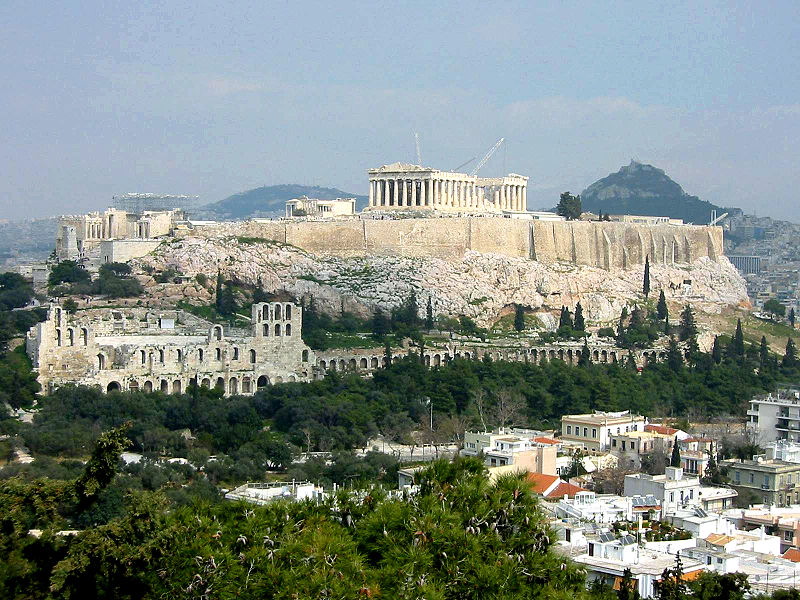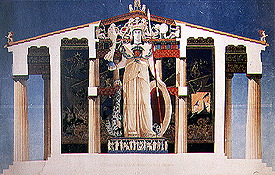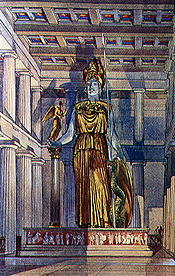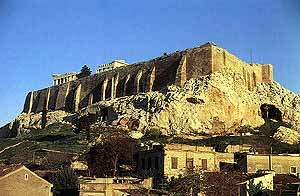BANHAM, R., Teoría y diseño en la primera era de la máquina. Edit. Paidos. Barcelona, 1977.
Págs. 37-50. Choisy: Racionalismo y técnica.
Choisy coloca entonces a este estilo, digno de alabanza por su pureza abstracta de formas sin decoración (el triglifo y la metopa no eran decoración para Choisy), en el contexto del agrupamiento pintoresco. Pintoresco debe entenderse aquí en su sentido estricto, no en el sentido superficial de las vistas de tarjeta postal. Ha de entenderse como una sucesión de cuadros (tableaux) que la visitante divisa al aproximarse al Partenón, y como un procedimiento deliberado, no accidental. Choisy compara las plantas de la Acrópolis antes y después de que el incendio hubiera arrasado la mayoría de sus edificios, y comenta que, si bien la primera Acrópolis era resultado de una acumulación de accidentes:
"...la otra está concebida de manera metódica, conforme a una concepción total y adaptada a un emplazamiento limpiado por el fuego; en esta nueva Acrópolis, las aparentes asimetrías son sólo un medio de conferir un aspecto pintoresco al grupo arquitectónico más hábilmente equilibrado que jamás haya existido".
Esto significa conceder un valor muy elevado a la composición pintoresca y señala un marcado contraste con la práctica de las Beaux-Arts y sus rutinarios ejes mayor y menor. Choisy identifica con exactitud las componentes del método pintoresco: el respeto por el lugar:
"los griegos nunca visualizaron un edificio sin el lugar que le servía de marco y sin los otros edificios que lo rodeaban... emplazándolo tal como lo hubiese hecho la naturaleza".
Aprovechamiento de factores dados
"la arquitectura se inclinaba ante estas sujeciones y las aprovechaba para sus fines particulares"
equilibrio de masas
"cada motivo arquitectónico es simétrico por sí mismo, pero cada grupo está tratado como un paisaje en el cual las masas se equilibran"
tal como las ve el ojo de un paseante situado al nivel del suelo:
"el método de equilibrio surgirá del estudio de las sucesivas imágenes que la Acrópolis del siglo v presentaba al visitante".
Y lo pintoresco no sólo conviene a los griegos; es también la manera de proceder de la naturaleza:
"Así procede la naturaleza... la simetría reina en cada una de las partes, mas la totalidad está sometida sólo a aquellas leyes del equilibrio para las cuales el término «equilibrio» es a un tiempo expresión física e imagen mental".
Este modo ad boc y natural de composición debía, evidentemente, atraer a Choisy como hombre práctico; pero no obstante, la vinculación del dórico griego, ejemplo fundamental de disciplina y regularidad arquitectónicas, con la composición asimétrica sigue siendo una notable realización en el contexto del diseño arquitectónico en Francia durante las postrimerías del siglo XIX. El mensaje no cayó en el vacío, y aunque las asimetrías de los edificios posteriores a la primera guerra mundial tendrían una base estética más complicada. las ilustraciones (y también los argumentos) de Choisy surgen en apoyo de las opiniones anti axiales de Le Corbusier. De todos modos, cabe dudar que Choisy comprendiera que estaba minando los métodos tradicionales de proyectar y que correspondería a una generación más joven hacer explotar las minas por él colocadas. Sus últimas palabras sobre Grecia son convencionales:
"El arte griego... parece ser un culto desinteresado a la idea de armonía y de belleza abstracta."
Choisy tiene, es cierto, pasajes blandos, donde dista mucho de alcanzar su mejor forma. Su concepción lógica y teleológica del desarrollo arquitectónico no admite prácticamente factores casuales tales como el ejercicio de la voluntad humana; como resultado, su actitud ante el Renacimiento es confusa y contradictoria, sobre todo porque no llegó a tomar en cuenta el amplio campo de los factores sociales. Análogamente, su estudio del siglo XIX dista de ser satisfactorio pues no tomó en cuenta el amplio campo de los factores técnicos. Parece no haber observado que, en la época en que escribía su libro, tanto las herramientas como los materiales sufrían una revolución y que (incluso según sus propias normas) también debía sufrir una revolución la arquitectura. Pero se detiene ante la Bibliothèque Nationale de Labrouste observando que se trata de un début lleno de plus que des promesses y guarda silencio respecto al último tercio del siglo. Entre tanto, la electricidad y el motor de combustión interna revolucionaban el outillage, y el acero y el hormigón armado la construction. Sin embargo, Choisy podía decir refiriéndose al aparejo de los constructores góticos:



























